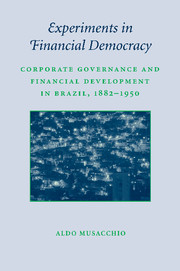 Experiments in Financial Democracy
Experiments in Financial Democracy Published online by Cambridge University Press: 30 January 2010
Corporate bond markets in Brazil grew to historical levels at the same time stock markets peaked. This chapter shows that the development of corporate bond markets was, to a large extent, linked to the protections for creditors in national bankruptcy laws. This chapter discusses the importance of the bond market and explains the evolution of the protections for creditors both on paper and by the courts between 1850 and 1945.
Beyond sheer size relative to GDP, the scale of development of Brazil's bond markets before 1920 is impressive in two respects. First, corporations in all sectors of the economy issued bonds to obtain funds. In fact, bond markets were among the most important sources of new funds for corporations (issuing companies secured approximately 30% of their capital through this channel). Second, the scale of Brazil's bond markets relative to the size of Brazil's economy suggests that a strong formal institutional system was in place to enforce bondholder rights (e.g., in the event of bankruptcy).
But although size should attest to the existence of an institutional framework for protecting creditors, the strength of creditor protections was called into question by research such as Gail Triner's influential study of Brazilian banking. Arguing that the “insufficient protection for the recovery of debt was a serious problem throughout the First Republic [1889–1930],” Triner maintained that the main problem for banks trying to recover unpaid debts was that “the laws and Commercial Code simply did not address issues involving financial property,” making it difficult for them to take possession of debtors' bank accounts and other financial assets.
To save this book to your Kindle, first ensure [email protected] is added to your Approved Personal Document E-mail List under your Personal Document Settings on the Manage Your Content and Devices page of your Amazon account. Then enter the ‘name’ part of your Kindle email address below. Find out more about saving to your Kindle.
Note you can select to save to either the @free.kindle.com or @kindle.com variations. ‘@free.kindle.com’ emails are free but can only be saved to your device when it is connected to wi-fi. ‘@kindle.com’ emails can be delivered even when you are not connected to wi-fi, but note that service fees apply.
Find out more about the Kindle Personal Document Service.
To save content items to your account, please confirm that you agree to abide by our usage policies. If this is the first time you use this feature, you will be asked to authorise Cambridge Core to connect with your account. Find out more about saving content to Dropbox.
To save content items to your account, please confirm that you agree to abide by our usage policies. If this is the first time you use this feature, you will be asked to authorise Cambridge Core to connect with your account. Find out more about saving content to Google Drive.